#transient killer whale
Text

Killer Whale (Orcinus Orca)
Taken off the coast of California
status: ???
Along the southern part of the California coast we can see what are referred to as Biggs/Transient killer whales or ETPs (Eastern Tropical Pacific). This individual is one of the Biggs population which is known for mammal hunting (such as predation on whale calves)! They are studied by a group of scientists called the California Killer Whale Project and thanks to them we know that this individual is a member of the CA140Bs (or CA23A2 who was also with them - it’s difficult to tell exactly which one is in this shot).
Anyway long winded way of sharing that I was lucky to see Orca in their natural habitat!!
#orca#killer whale#orcinus orca#whale watching#wildlife#wildlife photography#marine life#ocean wildlife#ocean animals#Pacific Ocean#CA140bs#biggs killer whale#transient killer whale
11 notes
·
View notes
Text

T072 Captain Hook passed through town yesterday! There were a few other transients further south that he was probably hanging out with but they didn't come up here :/ At least I got to see Captain Hook tho he's one of my favorites
1 note
·
View note
Text
You guys want Orca pun tea that helps fund orca conservation and research in the Salish Sea? (The names are, of course, based on the names of these three bull Transient orcas, all with big reputations)

#orca#marine biology#marine conservation#transient orca#transient killer whales#Biggs killer whales#Ooxjaa#chainsaw#rainy
80 notes
·
View notes
Text

“Surfacing”
Reference image by Kat Martin
#aleksi draws#aleksi ann#aleksiann#painting#artists on tumblr#acrylic#impasto#impasto painting#art#acrylic painting#orca#killer whale#t099#transient orca
23 notes
·
View notes
Text
2 notes
·
View notes
Photo
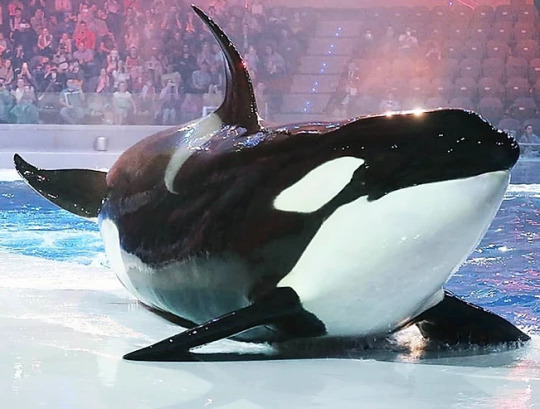
Narnia, has died at Moskvarium (est. 17 years old). The cause of death was intestinal volvulus. The press release does not issue the date of death, but its presumed to have occurred in January 2023. More details will be posted if they are released. Narnia was captured on August 11, 2012 in Reyneke Bay, Sea of Okhotsk, Russia.
(translated, Russian)
"Narnia passed away at the age of 17, she was the oldest representative of the Moskvarium killer whale family.
Until the last day, there were no signs of illness or illness in the behavior and medical records of Narnia.
The cause of death was established after a study, the results of which were received a few days later - Narnia died of acute intestinal volvulus. Unfortunately, toothed whales, including killer whales, are very often affected by this pathology. This pathology is described both in wild killer whales and dolphins, and in animals living in artificial conditions.
The departure of Narnia is an irreparable loss for the entire Moskvarium team."
Via Cetabase
8 notes
·
View notes
Text
April 28, 2022: Transients- Haro Strait

T049A3 and T049A6

T065B1 and T065B

T049A3 and T049A4

T065B1

T049A3
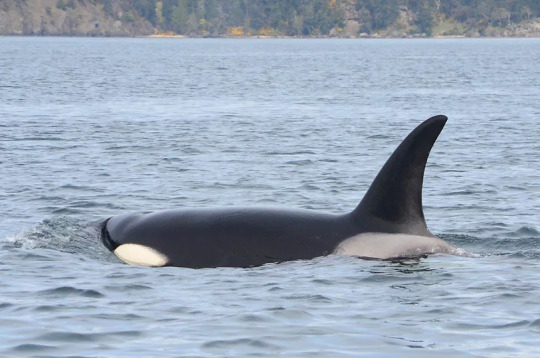
T049A4 and T049A6

T065B
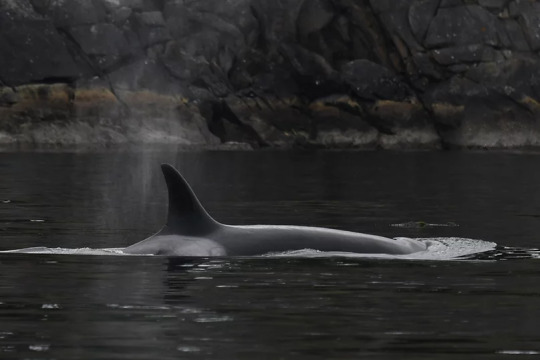
T049A and T049A6

T049A and T049A5

T049A and T049A3

T049A3 and T049A5

Photo Credit to the Center for Whale Research Encounter #19 - April 28, 2022
#T049A3#T049A6#T065B1#T065B#T049A4#T049A#T049A5#transients#west coast transients#Transient orcas#transient killer whales#biggs killer whales#West Coast Transients (Biggs)
6 notes
·
View notes
Text
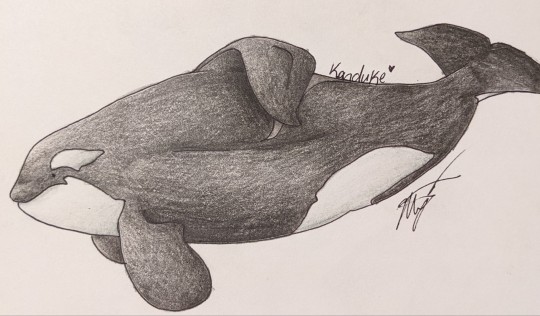
Kanduke, one of my all time favorite whales
#orca#orcas#killer whale#biggs transient#kanduke#seaworld#cetacean#ceta art#art#artists on tumblr#artistic#tradtional drawing#drawing#grims art
6 notes
·
View notes
Text

Transient Killer Whales art print poster. Available at cetek.etsy.com.
#orca#transient#bigg's orca#killer whale#artwork#whales#pacific northwest#orcinus orca#cetacea#dolphin
0 notes
Text

Transient (mammal-eating) Orcas painted in oil pastels
Art © RustedAshes (i.e. me). It is forbidden to copy/use without my written permission.
1 note
·
View note
Text

🚨 A team of scientists, led by Phil Morin of NOAA, have published a new paper formally proposing two “new” species of killer whale: Bigg’s killer whales (Orcinus rectipinna) and resident killer whales (Orcinus ater).🚨
More than fifty years ago, researchers began studying the killer whales found off the west coast of North America. One keen-eyed scientist, Dr. Michael Bigg, noticed that there appeared to be two kinds of killer whales: a smaller, more gregarious form that fed on fish and a larger, stealthier type that fed on marine mammals. He and his colleagues dubbed the fish-eaters “resident” killer whales and the mammal-eaters “transient” killer whales (who were later renamed Bigg’s killer whales in his honor).
Two female Bigg’s killer whales in Washington (top) and a male and female resident killer whale in Alaska (bottom)
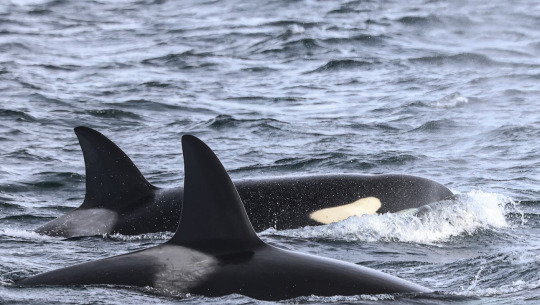

Many decades later, scientists have been hard at work trying to resolve whether or not these two forms are different species. It is not an easy task. This requires a thorough investigation into many factors, including evolutionary history, genetics, morphology, ecology, and behavior. In this paper, the researchers lay out all of the evidence and conclude that these two forms warrant elevation to species status.
As newly proposed species, both need new scientific names. There have been numerous killer whale species proposed and described in the past by other naturalists and researchers, including those in the North Pacific. Unfortunately, there are no type specimens— individual specimens upon which the first descriptions of a species are based—available for killer whales previously described from the North Pacific, so the researchers were left to examine drawings and illustrations of killer whales in the North Pacific in the late 1800s by Scammon and Cope.
The authors propose “Orcinus rectipinnus” for Bigg’s killer whales and “Orcinus ater” for resident killer whales. “Rectipinnus” presumably refers to tall dorsal fins, and “ater” means “black” or “dark” in Latin. Of note is the fact that a female killer whale from California originally examined and described by Scammon as “Orcinus rectipinnus” had seals in her stomach, suggesting she was a Bigg’s killer whale.
In addition, the authors note they are consulting with Indigenous tribes for a new common name for resident killer whales.
What’s next? In marine mammal biology, proposed taxonomic changes are reviewed by the Society for Marine Mammalogy’s taxonomy committee. If accepted, these species revisions become “official.” This has been an eagerly awaited paper by many in the field of killer whale biology and it is a great accomplishment, made possible by decades of research by scientists around the world.
A big thank you to lead author Phil Morin for letting me preview the manuscript and for answering my numerous questions in preparation for this post!
Read the paper here!
#killer whale#orca#science communication#marine biology#marine mammal#cetaceans#marine mammals#orcas#whales
543 notes
·
View notes
Text



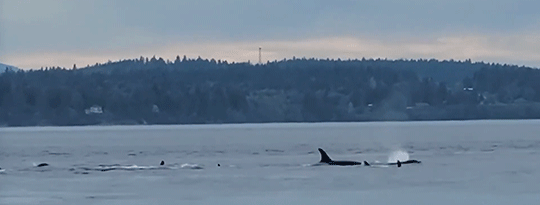
Southern resident orcas, also known as the southern resident killer whales (SRKW), are an exclusively fish-eating ecotype of orcas that live in and around the Salish Sea. They differ genetically from transient orcas as well as having different dialects and diets.
© Rachel Haight - Orca Network
814 notes
·
View notes
Text
More than 150 years ago, a San Francisco whaler noticed something about killer whales that scientists may be about to formally recognize—at least in name.
Charles Melville Scammon submitted a manuscript to the Smithsonian in 1869 describing two species of killer whales inhabiting West Coast waters.
Now a new paper published in Royal Society Open Science uses genetic, behavioral, morphological and acoustic data to argue that the orcas in the North Pacific known as residents and transients are different enough to be distinct species. They propose using the same scientific names Scammon is believed to have coined in the 19th century.
Continue Reading.
259 notes
·
View notes
Text

Bigg’s killer whale looking for a sea lion snack in the Salish Sea 02/08/24.
Photo from the Center for Whale Research
13 notes
·
View notes
Text

Orca acrobatics 💦 Captured here is a member of the T002 pod - a family of five transient orcas. Her nickname is Tasu and she was born in 1989. She has 2 sons, 2 daughters, and is a mighty good backflipper.
Transient killer whales, also known as Bigg's killer whales, travel the waters from southeast Alaska to Southern California!
📸: Kristian Gillies Photography
168 notes
·
View notes
Note
have you seen any of the grey transient killer whales off the west coast of north america? they’re beautiful! researchers aren’t exactly sure what causes the coloration. it’s hypothesized that chediak-higashi syndrome may be to blame, as it was documented in a captive individual from a related population. beautiful animals though, so far, none of the wild grey calves have survived to adulthood




Sorry for the late response, but wow! Absolutely stunning, I love faded black animals, they look like went through the wash too many times. So sad they have health issues!

#color mutation#killer whale#orcinus orca#orca#cetacean#oddball#Chediak Higashi syndrome#I swear I didn’t see this in my inbox
303 notes
·
View notes